
Robert Draws – Lian Sahar’s solo exhibition, titled Diam yang Bergerak (Silent in Motion), is being held at Lawangwangi Creative Space from February 21 to March 22, 2025. Despite passing away in 2010, Sahar’s legacy is being celebrated through this exhibit of his remarkable works. Born in 1933 in Kutacane, Aceh, Sahar spent most of his life in Yogyakarta, where he developed a unique artistic identity.
This exhibition, curated by Heru Hikayat and M. Dwi Marianto, showcases 64 pieces of Lian Sahar’s art. The collection consists of drawings and paintings on paper, including posters, portraits, figures, and abstract works. His ability to manipulate lines, shapes, and spaces creates dynamic, visually striking pieces that leave a lasting impression. The collection provides a rare opportunity to witness Sahar’s creative process up close.
Dwi Marianto, one of the exhibition curators, noted that people often stigmatized Sahar politically. They considered him aligned with the Lembaga Kebudayaan Rakyat (Lekra), an organization linked to leftist ideology. However, despite these political associations, his visual style was more aligned with abstract and abstract-expressionist art, which was quite different from Lekra’s typical artistic approach.
“Read about: Cultivating Religious Balance Through the Canvas of Art”
The exhibition features works sourced from the private collection of Muhammad, a professor at the Graduate School of Tourism at Gadjah Mada University. Muhammad collected Lian Sahar’s art for over 20 years, amassing hundreds of drawings, paintings, posters, and letters. Muhammad was captivated by the thin and thick lines that defined Sahar’s pieces. He describes the artist’s work as “an exploration of two-dimensional and three-dimensional elements in an amazing way.”
Sahar’s lines, particularly his use of both thin and thick strokes, left an impression on Muhammad, who began collecting his art in 1994. Through this personal connection, Muhammad preserved Sahar’s work, and Andonowati, Director of ArtSociates, later acquired it to protect it from damage caused by termites. Many of Sahar’s works had been in Muhammad’s care for decades, but now they have found a new home.
Lian Sahar’s artistic journey is deeply rooted in his early life experiences. According to Merwan Yusuf, his younger brother, Sahar received a scholarship to continue his studies as a member of the Tentara Pelajar (Student Army) during the Indonesian Revolution. People believe that before pursuing his art education at the Yogyakarta Art Academy, he briefly studied law at the University of Indonesia and fine arts at the Bandung Institute of Technology.
In Yogyakarta, Sahar founded and ran Studio Pualam Timur, where he worked on various aesthetic projects for government offices, residences, and galleries. His professional journey began in 1956, and he held his first solo exhibition in 1968 at the Indonesian Embassy in Singapore.
“Read more: El Valle Grita Culture Music & Art Festival, Music Ispiration”
Between 1970 and 1971, Sahar participated in exhibitions across Southeast Asia, the United States, and Japan. He showcased his work in the Pameran Besar Seni Lukis Indonesia in 1974 at Taman Ismail Marzuki.
People recognized his artistic talent. He won a prestigious prize in 1976. He shared this honor with fellow artists Ahmad Sadali, Zaini, Oesman Effendi, and A.D. Pirous.
Sahar continued to mark his later years with exhibitions. He held his final solo exhibition, Dimana Tak Dinama (Where the Untold Lies), in 2006 at Balai Rupa Tembi in Yogyakarta. He also participated in his final group exhibition, Manifesto, at the National Gallery of Indonesia in Jakarta in 2008.
Lian Sahar’s death in 2010 left a profound impact on the Indonesian art scene. He left behind his wife, B.M. Susanti, and four children. His works continue to inspire new generations of artists and art enthusiasts, and his contributions to Indonesian art history are immeasurable. The ongoing exhibition at Lawangwangi Creative Space is a fitting tribute to this influential artist and his unique vision.